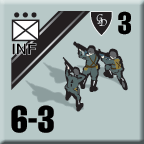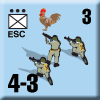| Panzer Grenadier: 1940 The Fall of France
Scenario Preview, Part Five
By Mike Bennighof, Ph.D.
October 2022
.jpg) The 1940 campaign in France might have only lasted six weeks, but at the tactical level (where the fighting actually happens) it was no walkover for the Germans. That’s the theme of our Panzer Grenadier: 1940 The Fall of France and no part of it shows that better than the fourth chapter, Tank Battle at Stonne. The 1940 campaign in France might have only lasted six weeks, but at the tactical level (where the fighting actually happens) it was no walkover for the Germans. That’s the theme of our Panzer Grenadier: 1940 The Fall of France and no part of it shows that better than the fourth chapter, Tank Battle at Stonne.
The French armor met the German panzers head-on, and over the next four days the village of Stonne changed hands no less than 17 times. The French eventually gave way, but had shown that they had no less will to fight than had their fathers in the Great War. German officers at the time compared the battle to that at Verdun in 1916; afterwards they would cite Stonne alongside Stalingrad.
So let’s have a look at our version of this intense battle (the first half, anyway – there’s a lot of action in this chapter):
Chapter Four
Tank Battle at Stonne
Heinz Guderian’s oversized XIX Corps boasted three panzer divisions, plus an independent motorized regiment. So far, French resistance had been brushed aside and the 55th and 71st Infantry Divisions, reservist “Series B” outfits lacking their full complement of anti-tank guns, utterly crushed with thousands of prisoners taken. The Germans had driven to the River Meuse, where they prepared to make even greater advances.
After holding a victory parade, Guderian decided to divide his force in the face of the enemy, a cardinal sin of basic military strategy. The 1st and 2nd Panzer Divisions would veer off to the west and into the Allied rear areas, while 10th Panzer Division and the Grossdeutschland Infantry Regiment would press southward over the river. But coming up to block his advance was the well-equipped French 3rd Armored Division and 3rd Motorized Infantry Division. The next stage of the German advance would not be so easy.
Scenario Seventeen
Hell River
13 May 1940
Sedan, France
 The Germans planned carefully for their assault on the heavily-fortified Meuse River in the French Ardennes. Thorough reconnaissance pinpointed every French bunker, and spies confirmed that most of the fortifications around Sedan had not been completed. First Panzer Division and Infantry Regiment Grossdeutschland would spearhead the attack on the city. A five-hour aerial bombardment fell on Sedan the morning of 13 May, and in the silence that followed the German ground forces attacked. The Germans planned carefully for their assault on the heavily-fortified Meuse River in the French Ardennes. Thorough reconnaissance pinpointed every French bunker, and spies confirmed that most of the fortifications around Sedan had not been completed. First Panzer Division and Infantry Regiment Grossdeutschland would spearhead the attack on the city. A five-hour aerial bombardment fell on Sedan the morning of 13 May, and in the silence that followed the German ground forces attacked.
Conclusion
The Germans deployed smoke to conceal the troops paddling furiously across the river. Still shocked by the incredible force of the aerial bombardment, the French finally emerged from their shelters and began firing at the attacking German forces. Bunker Number 211 put up fierce resistance, causing the Germans to bring up artillery and assault guns to fire directly at the pillbox openings. German engineers led the assault on the French fortifications, using demolition charges to clear the French trenches. French resistance crumbled under the seemingly-unstoppable German momentum, and in just a few hours the Germans had established a two-kilometer-deep bridgehead.
Notes
This scenario appeared in the first edition; there’s been some revision for the Playbook edition. It’s still just a little scenario, with a crack German force trying to bash its way against a well-held river line. The French have fortifications and machine guns, and really poor morale. The Germans get a decided edge in numbers, sky-high morale, plenty of leaders and the awesome Bufla bunker-busting self-propelled cannon. There’s also a lot of German artillery, but poor communications will make it hard to use on the French side of the river.
Scenario Eighteen
Seigneur Suis
14 May 1940
Between Chémery and Connage, South of Sedan, France
 The 7th Bataillon de Chars Légers’s motto, "Seigneur Suis" (loosely translated: “I’m the boss”), summed up the French tankers’ attitude. They drove the rare FCM36 light tank, which had impressive armor protection but still carried the old 37SA18 gun that couldn’t do much damage to German main battle tanks. The battalion’s 3rd Company had orders to attack the Sedan bridgehead, and on 14 May the tanks began their slow advance up the winding road to Connage on the way to Sedan. The 7th Bataillon de Chars Légers’s motto, "Seigneur Suis" (loosely translated: “I’m the boss”), summed up the French tankers’ attitude. They drove the rare FCM36 light tank, which had impressive armor protection but still carried the old 37SA18 gun that couldn’t do much damage to German main battle tanks. The battalion’s 3rd Company had orders to attack the Sedan bridgehead, and on 14 May the tanks began their slow advance up the winding road to Connage on the way to Sedan.
Conclusion
With overly cautious infantry trailing behind instead of seeking the enemy, the lead French tank was soon immobilized by a German anti-tank gun hidden in the woods along the road. The tanks pressed on as more German guns opened fire, but eventually their progress slowed to a snail’s pace since they had to keep stopping to allow their infantry to catch up. When the armored column reached Connage, German anti-tank guns firing from the heights above the town immobilized two more tanks. Then German tanks appeared in the village streets, and a short fight erupted at close range between two platoons of FCM and a handful of panzers plus a monstrous self-propelled gun. The French caught the worst of it, and only three French tanks escaped back to French lines.
Notes
Another holdover from the first edition, this time with only minor revision. This is another small scenario, with the French attacking first and then holding on against a powerful German counter-attack. The French infantry is truly execrable, and while their tanks aren’t all that good either they also have to contend with the Bufla, which can destroy them at seemingly interstellar ranges.
Scenario Nineteen
Early Morning at Stonne
15 May 1940
Stonne, South of Sedan, France
 On a long ridge south of Sedan sit the woods of Mont-Dieu and a little hilltop village called Stonne. These lay directly in the path of Guderian’s motorized infantry expanding the Sedan bridgehead across the Meuse. As French forces crumbled before Guderian’s advance, 3rd Division d’Infanterie Motorisée (DIM) and 3rd Division Cuirassée de Réserve (DCR) hurried forward to occupy the heights at Stonne and restore the line. On a long ridge south of Sedan sit the woods of Mont-Dieu and a little hilltop village called Stonne. These lay directly in the path of Guderian’s motorized infantry expanding the Sedan bridgehead across the Meuse. As French forces crumbled before Guderian’s advance, 3rd Division d’Infanterie Motorisée (DIM) and 3rd Division Cuirassée de Réserve (DCR) hurried forward to occupy the heights at Stonne and restore the line.
Conclusion
The French did not have enough time to establish proper defensive positions at Stonne before the Grossdeutschland regiment attacked at dawn on 15 May. After an initial artillery barrage, German soldiers climbed the steep slopes followed by panzers on the winding road. French 25mm guns and Panhards destroyed five German tanks, but the rest wreaked havoc in the streets and the French quickly abandoned the village. French armored reinforcements arrived and counterattacked along with some of the infantry that had retreated. The Germans resisted fiercely, and held off the French infantry while destroying several H39 tanks. Only the arrival of several huge B1-bis tanks later that morning would turn the tide against the Germans.
Notes
This is another heavily-revised version of a first edition scenario. The Germans are very good, with high morale, many leaders and lots of artillery support. The French are almost as good, and they have the Char B1bis.
Scenario Twenty
Grossdeutschland Panics
15 May 1940
Stonne, South of Sedan, France
 With the Germans still holding out in Stonne, the French 3rd DIM sent a force including its reconnaissance group to kick them out. The neighboring 3rd DCR added tanks to the counter-attack, giving the French a well-balanced combined-arms team. The Germans considered themselves an elite unit, and they certainly had received favorable treatment in terms of manpower and equipment. But they had not yet encountered the French Char B1 bis heavy tank. With the Germans still holding out in Stonne, the French 3rd DIM sent a force including its reconnaissance group to kick them out. The neighboring 3rd DCR added tanks to the counter-attack, giving the French a well-balanced combined-arms team. The Germans considered themselves an elite unit, and they certainly had received favorable treatment in terms of manpower and equipment. But they had not yet encountered the French Char B1 bis heavy tank.
Conclusion
As the French tanks advanced on the village, German soldiers sniped at the oncoming French infantry from the top of the village’s water tower. A hail of anti-tank shells immobilized or destroyed several French light tanks, and the French infantry eventually chose to bypass the village through the western woods. They captured a position in the western part of Stonne, and as the Germans fought to repel them the French tanks closed the pincers on the village. Soon, most of the Germans could be seen running and driving away from the deadly heights. The “bodyguard of the German people” had broken and fled the battlefield in its first serious engagement of the war.
Notes
We had this scenario in the first edition as well, but Philippe made some revisions and I made some more. The first edition version played well as published, but not for the right reasons. Now we have good history and good game-play. And it’s always a good day when the German uberelite run away in panic.
And that’s the first half of Chapter Four!
You can order 1940: The Fall of France right here.
Please allow an extra two weeks for delivery.
Sign up for our newsletter right here. Your info will never be sold or transferred; we'll just use it to update you on new games and new offers.
Mike Bennighof is president of Avalanche Press and holds a doctorate in history from Emory University. A Fulbright Scholar and NASA Journalist in Space finalist, he has published a great many books, games and articles on historical subjects; people are saying that some of them are actually good.
He lives in Birmingham, Alabama with his wife, three children, and new puppy. He misses his lizard-hunting Iron Dog, Leopold.
Want to keep Daily Content free of third-party ads? You can send us some love (and cash) through this link right here.
|
